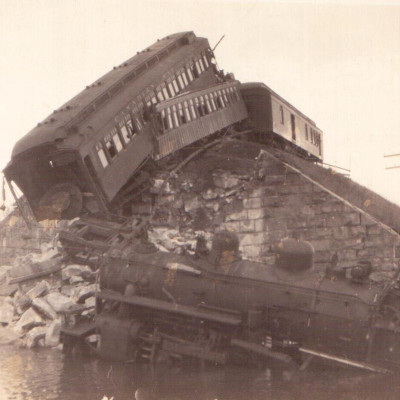--January 19, 2018.
The nineteenth and early twentieth centuries saw a huge railway boom across the Eastern Townships. It was driven by the need to access raw materials, a desire for quick transportation, the growth of industry, and a mania to build more and more branch lines. Literally dozens of railway companies competed for territory and markets.
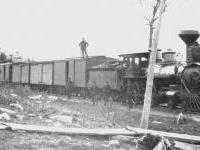 1) This photo, taken near Lake Megantic in the 1880s, shows a Canadian Pacific locomotive, followed by a coal car and two passenger cars. What is the name of the fan-shaped attachment at the front of the locomotive?
1) This photo, taken near Lake Megantic in the 1880s, shows a Canadian Pacific locomotive, followed by a coal car and two passenger cars. What is the name of the fan-shaped attachment at the front of the locomotive?
a) A buffalo basher
b) A groundhog squasher
c) A cowcatcher
d) A snowplough
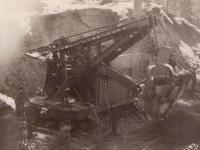 2) Railroad construction required large gangs of labourers, and heavy equipment to move earth, ballast, railroad ties and rails. What is the name of the machine depicted in this scene, taken during construction of the Orford Mountain Railway c.1905?
2) Railroad construction required large gangs of labourers, and heavy equipment to move earth, ballast, railroad ties and rails. What is the name of the machine depicted in this scene, taken during construction of the Orford Mountain Railway c.1905?
a) A steam shovel
b) A locomotive
c) A pile driver
d) None of the above
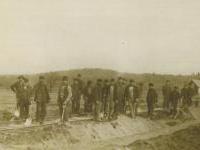 3) Gangs of migrant labourers were hired to work on several of the railroads in the Townships. The workers in this photo, taken on the line of the Orford Mountain Railway, were...?
3) Gangs of migrant labourers were hired to work on several of the railroads in the Townships. The workers in this photo, taken on the line of the Orford Mountain Railway, were...?
a) Venezuelans
b) Italians
c) Spaniards
d) Mexicans
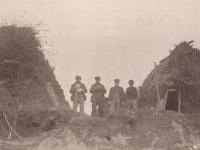 4) What are the structures seen in this photo, taken on the Orford Mountain Railway near Mansonville, c.1905?
4) What are the structures seen in this photo, taken on the Orford Mountain Railway near Mansonville, c.1905?
a) Food storage huts
b) Employee lounges
c) The manager's quarters
d) Workers' accommodations
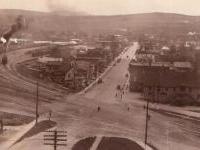 5) Railway lines were built through towns large and small. In fact, communities that did not find themselves along the line of a railway ran the risk of becoming backwaters. The town in this c.1910 photo was a major railway stop, as seen by the busy rail yard on the left. It was also, more recently, the scene of a terrible railway tragedy. Name it!
5) Railway lines were built through towns large and small. In fact, communities that did not find themselves along the line of a railway ran the risk of becoming backwaters. The town in this c.1910 photo was a major railway stop, as seen by the busy rail yard on the left. It was also, more recently, the scene of a terrible railway tragedy. Name it!
a) Megantic
b) Sherbrooke
c) Magog
d) Granby
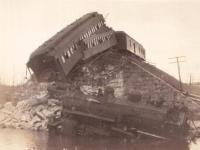 6) Wrecks and derailments periodically shattered the peace of the countryside. Piles of twisted metal, work crews, heavy machinery, and lots of noise, were the result. They were also things of fascination that never failed to capture the attention of local photographers. This wreck occurred in Kingsey in 1927, on the line of the Canadian National Railway. What phenomenon are the passenger cars exhibiting?
6) Wrecks and derailments periodically shattered the peace of the countryside. Piles of twisted metal, work crews, heavy machinery, and lots of noise, were the result. They were also things of fascination that never failed to capture the attention of local photographers. This wreck occurred in Kingsey in 1927, on the line of the Canadian National Railway. What phenomenon are the passenger cars exhibiting?
a) Crunching
b) Bunching
c) Telescoping
d) The domino effect
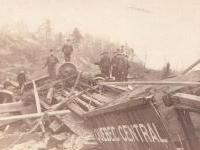 7) A Canadian Pacific trestle bridge over the North Missisquoi River famously collapsed with a train on it in 1907, killing two men. Where did this wreck take place?
7) A Canadian Pacific trestle bridge over the North Missisquoi River famously collapsed with a train on it in 1907, killing two men. Where did this wreck take place?
a) Magog
b) Bolton
c) Eastman
d) Granby
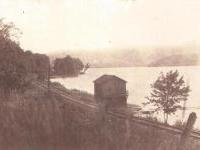 8) The choice of construction routes depended on many factors. A direct route meant lower costs. But negotiating obstacles like mountains, swamps, and large rivers entailed engineering challenges, time and expense. Much of the Massawippi Valley Railway (later the Boston & Maine), completed between Newport Vermont, and Lennoxville in 1870, followed the banks of Lake Masssawippi and the Tomifobia and Massawippi rivers. Where was this c.1920 photo taken?
8) The choice of construction routes depended on many factors. A direct route meant lower costs. But negotiating obstacles like mountains, swamps, and large rivers entailed engineering challenges, time and expense. Much of the Massawippi Valley Railway (later the Boston & Maine), completed between Newport Vermont, and Lennoxville in 1870, followed the banks of Lake Masssawippi and the Tomifobia and Massawippi rivers. Where was this c.1920 photo taken?
a) Ayer's Cliff
b) North Hatley
c) Lennoxville
d) Beebe
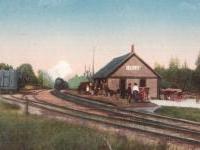 9) This is a view of the train station in Bury. Name the railway line!
9) This is a view of the train station in Bury. Name the railway line!
a) The Quebec Central
b) Canadian National
c) Canadian Pacific
d) The Grand Trunk
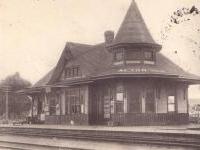 10) Some companies adopted a very specific architectural style for their stations. The picturesque Acton Vale station, seen here c.1905, was built by which railway?
10) Some companies adopted a very specific architectural style for their stations. The picturesque Acton Vale station, seen here c.1905, was built by which railway?
a) The Grand Trunk
b) The Quebec Central
c) The South Eastern Railway
d) The Drummond County Railway
All photos courtesy of the Matthew Farfan Collection.
Click here for the answers....but NO peeking!!
